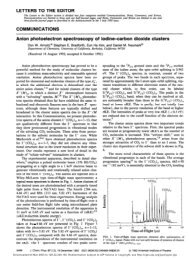Slow Electron Velocity-Map Imaging of Negative Ions: Applications ...
Slow Electron Velocity-Map Imaging of Negative Ions: Applications ...
Slow Electron Velocity-Map Imaging of Negative Ions: Applications ...
You also want an ePaper? Increase the reach of your titles
YUMPU automatically turns print PDFs into web optimized ePapers that Google loves.
CENTENNIAL FEATURE ARTICLE<br />
J. Phys. Chem. A 2008, 112, 13287–13301 13287<br />
<strong>Slow</strong> <strong>Electron</strong> <strong>Velocity</strong>-<strong>Map</strong> <strong>Imaging</strong> <strong>of</strong> <strong>Negative</strong> <strong>Ions</strong>: <strong>Applications</strong> to Spectroscopy and<br />
Dynamics †<br />
Daniel M. Neumark*<br />
Department <strong>of</strong> Chemistry, UniVersity <strong>of</strong> California, Berkeley, California 94720, and Chemical Sciences<br />
DiVision, Lawrence Berkeley National Laboratory, Berkeley, California 94720<br />
ReceiVed: August 12, 2008; ReVised Manuscript ReceiVed: October 7, 2008<br />
Anion photoelectron spectroscopy (PES) has become one <strong>of</strong> the most versatile techniques in chemical physics.<br />
This article briefly reviews the history <strong>of</strong> anion PES and some <strong>of</strong> its applications. It describes efforts to<br />
improve the resolution <strong>of</strong> this technique, including anion zero electron kinetic energy (ZEKE) and the recently<br />
developed method <strong>of</strong> slow electron velocity-map imaging (SEVI). <strong>Applications</strong> <strong>of</strong> SEVI to studies <strong>of</strong> vibronic<br />
coupling in open-shell systems and the spectroscopy <strong>of</strong> prereactive van der Waals complexes are then discussed.<br />
I. Introduction<br />
Since its first implementation in 1967, 1 anion photoelectron<br />
spectroscopy (PES) has evolved into a highly versatile technique<br />
capable <strong>of</strong> addressing fundamental problems in spectroscopy<br />
and chemical dynamics. In PES, outlined schematically in Figure<br />
1, mass selected negative ions are photodetached with a fixedfrequency<br />
light source, typically a pulsed or intense cw laser,<br />
and the resulting kinetic energy and angular distribution <strong>of</strong> the<br />
ejected photoelectrons are measured:<br />
ABC - hν<br />
98 ABC + e<br />
-<br />
The neutral species ABC can be any species with a positive<br />
electron affinity, including some closed shell molecules and most<br />
free radicals. The PE spectrum then yields the electron affinity<br />
<strong>of</strong> ABC, the energetics <strong>of</strong> those excited electronic states that<br />
are accessible at the photodetachment energy, and, in favorable<br />
cases, vibrational frequencies for the active vibrational modes<br />
in each observed electronic state. The intensity progressions in<br />
these modes probe changes in geometry between the anion and<br />
neutral electronic states.<br />
Since the anions are mass-selected prior to photodetachment,<br />
anion PES has proved extremely useful in elucidating energetic<br />
and spectroscopic trends in studies <strong>of</strong> size-selected clusters,<br />
where, for example, it can be used to probe the electronic states<br />
<strong>of</strong> a neutral metal cluster as a function <strong>of</strong> the number <strong>of</strong><br />
constituent atoms, mapping out the evolution <strong>of</strong> electronic<br />
structure from the atomic to bulk limits. 2-8 Alternatively, one<br />
can study the energetic and spectroscopic effects <strong>of</strong> stepwise<br />
solvation<strong>of</strong>anionsrangingfromatomichalidestobiomolecules, 9-12<br />
† 2008 marked the Centennial <strong>of</strong> the American Chemical Society’s<br />
Division <strong>of</strong> Physical Chemistry. To celebrate and to highlight the field <strong>of</strong><br />
physical chemistry from both historical and future perspectives, The Journal<br />
<strong>of</strong> Physical Chemistry is publishing a special series <strong>of</strong> Centennial Feature<br />
Articles. These articles are invited contributions from current and former<br />
<strong>of</strong>ficers and members <strong>of</strong> the Physical Chemistry Division Executive<br />
Committee and from J. Phys. Chem. Senior Editors.<br />
* To whom correspondence should be addressed. E-mail: dneumark@<br />
berkeley.edu.<br />
(1)<br />
and the solvation <strong>of</strong> electrons by water, 13-15 ammonia, 16,17 and<br />
other solvent molecules. 18,19 The species ABC does not have to<br />
be a stable species at all and, in fact, can be a transition state<br />
for a bimolecular or unimolecular chemical reaction. In such a<br />
case PES provides a means <strong>of</strong> carrying out “transition state<br />
spectroscopy”, yielding vibrational levels <strong>of</strong> this elusive species,<br />
which is <strong>of</strong> central importance to much <strong>of</strong> chemistry. 20,21 Finally,<br />
the anion can have multiple negative charges, enabling gas phase<br />
studies <strong>of</strong> the multiply charged anions that play a key role in<br />
aqueous solution chemistry. 22<br />
A key factor in the versatility <strong>of</strong> anion PES is its relative<br />
simplicity; the information described above can generally be<br />
obtained at a single or at most a small number <strong>of</strong> detachment<br />
wavelengths. Hence, the photoelectron spectrum <strong>of</strong> any negative<br />
ion can, in principle, be measured with a reasonably simple laser<br />
system. However, this simplicity comes at a cost in energy<br />
resolution, which is determined not by the light source but the<br />
method used to analyze the electron kinetic energy distribution.<br />
This resolution is typically limited to 5-10 meV and can be<br />
much poorer. At this level <strong>of</strong> resolution, one can resolve<br />
vibrational and electronic fine structure in small molecules with<br />
a relatively sparse manifold <strong>of</strong> vibrational levels, but in species<br />
such as metal or semiconductor clusters, where there are<br />
typically numerous low-frequency vibrational modes, vibrational<br />
structure can be resolved only in favorable cases. When only<br />
electronic structure is resolved in cluster photoelectron spectra,<br />
one can infer structural information through comparison with<br />
electronic structure calculations, but there is considerably more<br />
ambiguity in the interpretation <strong>of</strong> the spectrum.<br />
These considerations have driven efforts to develop photodetachment<br />
experiments that <strong>of</strong>fer better resolution than PES<br />
while retaining as much <strong>of</strong> its flexibility and versatility as<br />
possible. One such method is anion zero electron kinetic energy<br />
(ZEKE) spectroscopy, 23 based on the analogous method developed<br />
for neutral species in the mid 1980s. 24,25 In anion ZEKE<br />
spectroscopy, as indicated in Figure 1, anions are detached with<br />
a tunable laser, and only those electrons produced with nearly<br />
zero kinetic energy are detected. Anion ZEKE indeed <strong>of</strong>fers<br />
energy resolution as high as 0.1-0.2 meV, considerably better<br />
10.1021/jp807182q CCC: $40.75 © 2008 American Chemical Society<br />
Published on Web 11/26/2008



